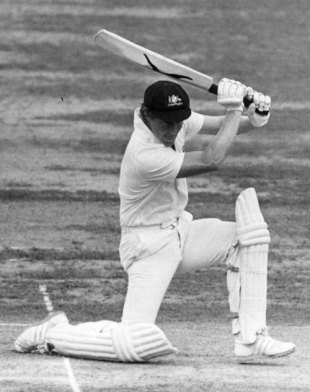Reviewing Kim Hughes
|
|
 |
I've just finished reading Golden Boy: Kim Hughes and the Bad Old Days of Australian Cricket , Christian Ryan's biography of Kim Hughes and have a few thoughts to offer (to add to Michael Jeh's piece). First off, this is a good read. Ryan writes fluently, and conveys the sheer physicality of cricketing action remarkably well. There are many colorful turns of phrase, and they are all needed when describing a) a cricketer as interesting as Hughes and b) a cricketing culture as hard-boiled as the Aussie one. Ryan's English is unmistakably Australian, with its directness and verve, and he has done well to construct the book as a kind of oral history, based on extensive interviews with many of the participants--players, coaches, journalists--in the Hughes saga.
I've always wondered whether my unbridled admiration of Hughes's dazzling, fleet-footed strokeplay was an aberration and I'm glad to find out that other kids (including some that went on to become Test cricketers) thought just as highly of his dancing down the pitch, his cover driving on bended knee, and his luscious pulling and hooking of the world's best fast bowlers. It's a pleasure to read about the three Test innings played by Hughes that have entered cricketing lore as all-time classics: the 213 at Adelaide vs India in the 1980-81 series, the 100* at Melbourne against the West Indies during the 1981-82 series, and the 84 against England during the 1980 Centenary Test at Lords. If you like extravagant strokeplay, you should buy the book just for the photographs of Hughes batting in the Centenary Test. There is one photograph in particular, that will leave you breathless, and wondering "How the hell does someone play that?" (If you are curious, go to Patrick Eagar's website, search for Kim Hughes, and browse; you'll know when you hit it).
When it comes to describing the bad old days of Australian cricket, the Chappell-Lillee-Marsh saga of relentless conspiracy and non-cooperation is depressing but in the end, it is just one component of a larger dysfunctionality in Aussie cricket at the time. Ryans most salutary contribution to Australian cricket writing is debunk some persistent Aussie myths about the cricketing scene (besides mateship). No one who reads this book will ever again believe that when it comes to sledging, what happens on the ground stays on the ground, and that folks just shake hands after a game and make up (at the least, such feelings about on-ground conflicts don't seem to be universally held amongst Australians). At times, in Ryan's telling, Australian cricket seemed to have as much factionalism as Indian cricket, and that's saying something. But it is no surprise to find out just how badly cricketers were treated by administrators. At times, one marvels at the sheer feudalism of crickets managers.
As I wrote to Christian earlier today, there is an interesting book waiting to be written about the relentless image construction of Australian cricketing lore and history, as conducted by CA/ACB/PBL/NineMSN et al over the last 20-25 years. The souvenirs hawked on Channel 9 are just one part of it. Christian has already contributed to this process with his revelatory article on the singing of Under the Southern Cross and it's place in dressing-room post-match rituals. Next in line should be a piece on the mythology of the baggy green, which Ryan alludes to in the book, which Ian Chappell has already sought to dispel, and which might, in many ways, be by far the hardest to do.
Kim Hughes was not a simple man; he had many personal and cricketing faults. But in full flight, he was a sight to behold, and brought pleasure to many cricket spectators, including a young Indian schoolboy in India in 1979, who intends to write a blog post describing that obsession in the next couple of days. Ryan has written a book as only a fan of Hughes the batsman could, as one who struggles to understand why the glory of a an epic innings is not consonant with the considerably less glamorous facts of the politics of cricket. I'm glad he has written this book; I hope he has others in store.
Samir Chopra lives in Brooklyn and teaches Philosophy at the City University of New York. He tweets here

